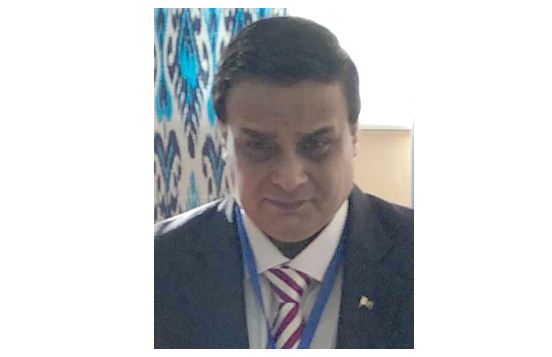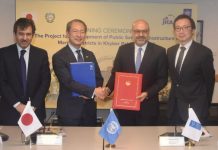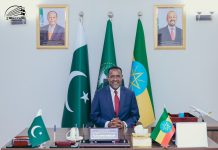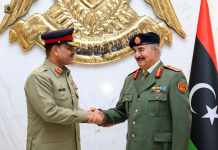Pakistan will be benefited from increasing close ties with Uzbekistan which is indeed a gateway of Central Asia and has borders with Turkmenistan, Kazakhstan, Tajikistan, Kyrgyzstan and Afghanistan. On its parts, Pakistan offers shortest and easy route for connecting with Central Asia its seaport are value-addition
Dr. Mehmood Ul Hassan Khan
Uzbekistan the real “jewel” of the Central Asian Region (CAR) has been striving hard to get connected with outer world to achieve extra-regional socio-economic, geopolitical and geostrategic “integration” with South Asia Region (SAR) and beyond. For the further strengthening of bilateral relations and achieve the dreams of greater regional connectivity, an international conference entitled “Central Asia and South Asia: Regional Connectivity. Challenges and Opportunities” will be held on July 15 in Tashkent. It would be a new chapter in the national history and commercial diplomacy of Uzbekistan.
Now Uzbekistan’s “Double Landlocked Syndrome (DLS)” has been successfully “swayed” through implementation of constant structural economic reforms having strong political commitment and “Immaculate Conception” of conflict resolution strategies of the President H.E. Shavkat Mirziyoyev. It will be further be consolidated after the successful holding of international conference which will be a giant step towards achieving the optimal levels of regional connectivity and immense socio-economic integration, energy and food cooperation between the Central Asia and South Asia.
It’s “Massive Drive of Diversification of Economy (MDDE)”, “Pragmatic & Friendly Foreign Policy Module (PFPM)” and last but not the least, “Holistic Model of Connectivity (HMC)” based on “shared prosperity” has now been getting “momentum” and new “heights” since the start of presidency of Shavkat Mirziyoyev 2017.
The upcoming international conference would be vivid reflection of rich multiculturalism of Uzbekistan and for its further strengthening of multidimensional cultural supremacy Heads of Foreign States and governments, representatives of international organizations, financial institutions, investment funds and companies, as well as global research and analytical centers, think tanks have already been cordially invited during which hearts and souls will be submerged to chalk out a comprehensive policy for achieving the greater regional connectivity.
On its part, being the “ideal” “connecting” hub between CAR and SAR having “easiest & shortest” route, Pakistan has been working hard to further strengthening the diplomatic ties with all the CAR especially the Republic of Uzbekistan in diverse fields of economy, trade & commerce, joint venture, foreign direct investment, food & energy cooperation, civil aviation, direct linkages, textiles, garments, automobiles, agro-economy/manufacturing, banking/finance, Islamic banking, micro-financing, insurance, science & technology, medical sciences, educational cooperation and last but not least, cultural cooperation.
According to reliable diplomatic resources and foreign office officials during the conference Pakistan will sign trade agreements with Uzbekistan to explore over US$90 billion exports potential in central Asia.
Moreover, both sides will hold a Joint Ministerial Commission (JMC) meeting in Tashkent on July 14, 2021 followed by Pakistan-Uzbekistan Trade, Investment and Connectivity Conference on July 15-16 for which a record numbers of potential investors and businessmen are going to Tashkent to attend this conference from Pakistan. The conference will be inaugurated by Prime Minister Imran Khan and the president of Uzbekistan.
Hopefully, several big trans-regional transport projects in the region will also be discussed especially most recently proposed trans-regional railways project, CASA-1000 and TAPI gas pipeline.
It is hoped after the successful conference the development of solid conceptual foundations for closer interaction between the regions of Central and South Asia will be further consolidated. It will facilitate the interregional agenda with specific projects of a strategic nature.
This conference will further gear-up Uzbekistan’s efforts for securing peace and stability in the region and achieving greater regional connectivity. Hopefully, Uzbekistan’s diplomatic efforts and spirits of commercial diplomacy will be showcased in the upcoming conference which will consequently strengthen its role as a reliable conductor and vital stabilizer/equalizer of all Central Asian states. Moreover, it will further strengthen Tashkent regional stature.
Pakistan will be benefited from increasing close ties with Uzbekistan which is indeed a gateway of Central Asia and has borders with Turkmenistan, Kazakhstan, Tajikistan, Kyrgyzstan and Afghanistan. On its parts, Pakistan offers shortest and easy route for connecting with Central Asia its seaport are value-addition.
Visionary leaderships of Uzbekistan and Pakistan H.E. Shavkat Mirziyoyev and Imran Khan have now further “redefined”, “rephrased”, re-shaped”, re-planned and re-implemented noble concept of regional connectivity by announcing numerous befitting Zero Customs Duties Regimes (ZCDRs), beneficial Strategic Oriented Policies/programs (SOPs), doable Trans-Regional Railway Project (TRP), the Innovative & Integrated Transportation System (IITS), TIR Carnets, Preferential Treatment Facility (PTFs) at Karachi Port Trust (KPT) and Gwadar seaports, the Quadrilateral Traffic in Transit Agreement (QTTA) and last but not least, Cluster Trading Scheme of Arrangements (CTSAs).
In this regard, both countries have agreed to allocate dedicated space in Gwadar and Tashkent for establishing warehousing facilities to help each other in the transportation of goods to other regional countries. A big Pakistani delegation will also participate in the business forum to be held during this international conference.
Uzbekistan’s Holistic Model of Connectivity (HMC) is primarily based on its macro-economic stability, sustainability and “transformation” through rigorous “structural reforms” initiated by the leadership of Shavkat Mirziyoyev which has now enabled his country to “expand” its trade & commerce relationship beyond the immediate neighborhood of the CAR. In this context the upcoming international conference will be instrumental.
To achieve this strategic goal, series of high officials meetings, interactive sessions, exchange of mutually beneficial proposals, economic incentives, trade promotion pledges, and last but not least, constant seaports facilitations has been rigorously discussed and consequently finalized which has actually revolutionized “concept” of regional connectivity between Pakistan and Uzbekistan.
Due to which “caravans” of Greater Regional Connectivity (GRC) have now further been stimulated and their successful Mutual Infinite Voyages (MIVs) of creating bridges of trust & trade, connecting minds & souls, merchandized commodities, commercial apparatus and of course Exchange of Valuable Services (EVSs) have been achieving new skies. It is indeed a giant and gigantic step towards modern revival of the ancient “Silk Route” of Uzbekistan.
Uzbekistan presented the concept of greater regional connectivity through the construction of the Mazar-i-Sharif-Kabul-Peshawar railway. The Uzbek Chairperson of the Senate, Tanzil Narbaeva termed it as the “event of the century”. Prime Minister Imran Khan described the project as the important connectivity project and endorsed Pakistan’s efforts for the early implementation of the railway line.
In this connection, dreams of greater regional connectivity will be further speed-up and streamlined with the implementation of the Mazari-Sharif-Kabul-Peshawar which will provide easy access to all the Central Asia countries particularly, to the Pakistan’s ports of Karachi, Port Qasim and Gwadar.
It is estimated that once this entire project is operationalized, the trade between Pakistan and Uzbekistan may reach up to 90 billion USD. Pakistan, Uzbekistan and Afghanistan has already signed US$4.7 trans-regional railway project. It has been jointly submitted to World Bank for approval.
In this regard, a road map was signed by all the participating countries in Tashkent. It is indeed a giant step towards regional integration of the CIS and South Asia Region which has combined population of 1.9 billion people 25 percent the world and a GDP of 3.5 trillion dollars.
Furthermore, most recently, the first shipment under the Convention on International Transport of Goods for traffic-in-transit of goods crossed the border and reached Pakistan from Uzbekistan via Afghanistan in 48 hours. It has actually diminished the concept of double landlocked doctrine and enhanced regional connectivity.
The Pakistan Ministry of Commerce labeled it a “new milestone” which has now been achieved as the result of collaboration between the transport companies of the two sides. It followed the successful shipment of first-ever cargo from Pakistan to Uzbekistan earlier this month. It labeled the beginning of a new era where trucks from both sides will take trade cargo to and from Karachi and Gwadar ports. It has successfully started exchange of goods and commodities between Faisalabad and Fergana.
The Embassy of Uzbekistan in Pakistan together with Pakistani transport company Best Trans Pvt Ltd and Uzbek freight forwarding company Asad Trans for the first time implemented a pilot trans-Afghan logistics project for direct delivery of Uzbek export goods to Pakistan through the territory of Afghanistan.
For further regional connectivity, in the near past, Uzbekistan’s Deputy Prime Minister for Investment and Foreign Trade, Sardor Umurzakov visited Pakistan and met with high dignitaries including Prime Minister Imran Khan, COAS General Bajwa and various Ministers. During his stay in Pakistan, Sardor Umurzakov showed his government’s willingness to become the Quadrilateral Traffic in Transit Agreement (QTTA) which has already been signed by Pakistan, China, Kyrgyzstan and Kazakhstan which has now further consolidated because of the construction of Karakoram Highway Phase Two.
Uzbekistan President H.E. Shavkat Mirziyoyev established strategic cooperation with Turkmenistan, Kyrgyzstan, Tajikistan and Kazakhstan which has now started a completely new political atmosphere based on mutual trust and good neighborliness in the CAR. Uzbekistan’s socio-economic oriented ties with Afghanistan are now bearing fruit and dividends. His “Border Integration the Key to Development” commercial diplomacy has further consolidated ties with Pakistan.
According to Uzbekistan official statistics (January 2021) due to constant structural reforms the average annual investment growth rate was 22 percent during the last four years. The total volume of foreign investment reached $26.6 billion, including direct investments of $17.5 billion.
Critical analysis indicates that the total volume of investments over the past 4 years has increased by more than 2.1 times, including foreign investments by 2.7 times. The share of investment of GDP in 2019 exceeded 38 percent for the first time, which created a solid foundation for ensuring economic growth in the coming years.
At the same time, the GDP of Uzbekistan in 2019 increased by 5.6 percent. Despite the complex and complicated economic conditions and ongoing COVID-19 pandemic the World Bank has predicted the country’s GDP growth in 2021 by 4.8 percent, which is one of the best indicators among developing countries.
Moreover, Uzbekistan’s foreign trade turnover is growing much faster than GDP and in 2019 increased by 26.2 percent, amounting to $42.2 billion. While in just 9 months of 2020, despite the pandemic, the country’s foreign trade reached $27.5 billion.
A “Joint Merchandise Shipping Company (JMSC)” may further enhance blue economy or trade through sea especially with Gwadar under the flagship project of the CPEC. A Joint Tourism Company (JTC) may be formed to attract more and more tourists from both the countries.
A Joint Infrastructural Development Company (JIDC) may be established to accelerate affordable housing schemes in both the countries. A Joint Railway Consultancy Company (JRCC) would be established to streamline the technical modalities of the proposed trans-regional railway project. A Joint Investment Company may be useful to mobilize and channelize domestic investments potential through innovative Sukuk Bonds. Revival of banking and financial integration is the need of the hour. Afterwards, Swapping of National Currencies Regime (SNCR) may be initiated to accelerate mutual inflows of trade & commerce.
Last but not least, formation of “Corridor of Knowledge (CK)” may be an “innovative” idea to stimulate the bilateral trade in the days to come.












